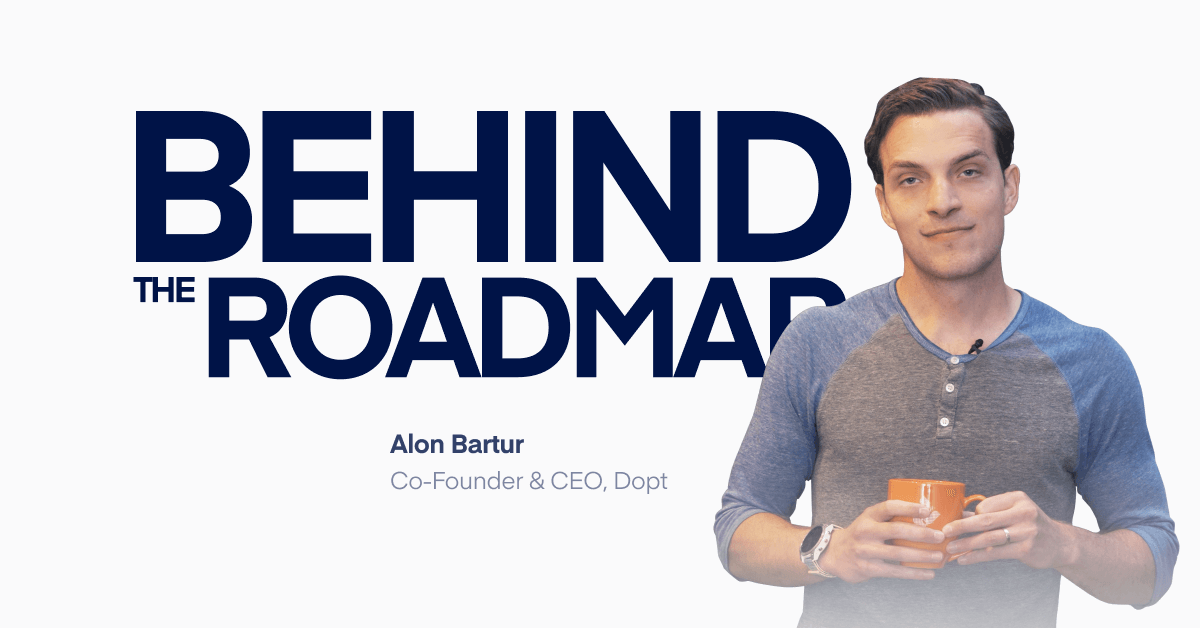Behind the Roadmap with Alon Bartur

Learnings From a Product Management Leader Turned Startup Founder
Editor’s note: This post is part of a brand new video series to understand what goes on behind the roadmap – it’s an inside look at the life of product managers. Watch the full first video here, the second here, the third here, and keep an eye out for upcoming installments!
The road to product management as a career isn’t always a straightforward one, and that’s why we’re taking you Behind the Roadmap for a deeper look at the life of product managers and product leaders.
We dive into their journeys into product management, their biggest challenges, greatest strengths, and so much more. It’s one part lifestyle, two parts nerding out on product.
(Want more on product professionals’ biggest challenges? See what 1400+ product managers and leaders had to say in the 2022 Product Excellence Report.)
Meet Alon Bartur
Formerly a product leader at Productboard, Alon is now a co-founder and the CEO of Dopt. Dopt combines a visual flow builder with software development kits (SDKs) and Application Programming Interfaces (APIs) that enable you to easily ship onboarding and engagement flows in hours, instead of the months it often takes.
How does his life as a former product manager helped in the process of starting his own company?
“There’s been a lot of carryover. I think one of the really nice parts about working in product management is you get to see so many different functions in a business and you really get to work with all different kinds of people, and get that big picture map of what the world looks like, which I think has been helpful.”
The difference in going “from zero to one”— or an established company, even a startup, to building your own — is that there are a lot of dimensions that aren’t fixed and all of them are interdependent. In previous roles, at least a little bit of that has already been established; you have an existing product with existing users. Now you have to ask all of the questions — who are you building a product for? What problems do they have? Is your solution actually solving their problems? Does it fit into their world?
You have to be really structured about how you talk to people and incorporate that information and work through fixing all of those dimensions.
Why that still doesn’t mean product managers are mini-CEOs
It’s a sometimes controversial statement. What’s Alon’s take on it?
“Often when product managers are thinking of themselves as a mini CEO, they’re acting dictatorially and they’re telling their design counterparts or their engineering counterparts what to do, which usually doesn’t go well and ends up eroding the team’s trust in them. I think where there are parallels is that successful PMs are extremely high ownership, frequently papering over all the gaps between things to make sure that a product is getting out the door successfully. There are a lot of parallels between that and what it’s been like founding a company and getting things off the ground.”
That’s a good lesson for product managers who do have aspirations of becoming the CEO one day; take on the role in such a way that you have high ownership and you’re looking to see how you can solve problems that exist in the gaps between teams and projects, not just trying to be the most Dangerous Animals in the room.
What is product-led growth?
There’s no one-size-fits-all answer, but in Alon’s words, “Some people will say that it’s not product led growth unless there’s inherent virality, like a loom or a notion where people are sharing and the product is actually acquiring new users for itself. But, I think the common ground is that the products have self-service experiences, and it’s critically important that the products connect users to value on their own.”
This is related to the rise of product teams dedicated to growth, getting tasked with figuring out how a product can most effectively connect users to the product’s value. But it’s not something where you can park a product team in the corner and tell them to go and solve the problem; it’s a whole company effort. Horizontal, cross-functional teams can be the best way to tackle it.
Deciding on the direction of a product
If you’re focused on growth, you have to be focused on what the problems are that your customers are trying to solve. It always comes back to the customers and deep understanding of what it is they’re actually trying to do (not just what they say they’re trying to do). Alon says at Dopt, “Customers are our North Star, and making sure that we understand who they are, what their problems are, are we actually solving those problems, that’s what’s going to help us build a valuable product and that’s what’s going to help us build a valuable business. On top of that, I think our experiences working in the ecosystem have been really helpful as well.”
Final thoughts
There’s a big difference between knowing that it’s hard to be the CEO of a startup and build a company and actually living it. How do you navigate that? Be really structured about what you do.
“It can feel overwhelming, like there’s no shortage of things that you need to get done. But, really thinking about all the work you do as an opportunity to learn, and then building the systems that you need to actually take the work that you’re doing and use that to understand, again, are we solving the right problems for the right people as we’re building this business, I think has been the thing that’s been most helpful.”
That’s good advice for product professionals in any stage of their career.
Thanks for coming with us Behind the Roadmap!
The conversation continues in the rest of the series, so keep an eye on our social feeds or right here on the blog for the next installment. And if you haven’t yet, check out the video here.




